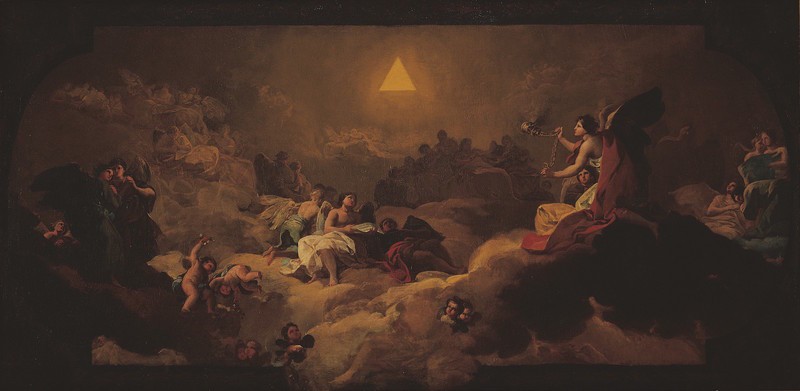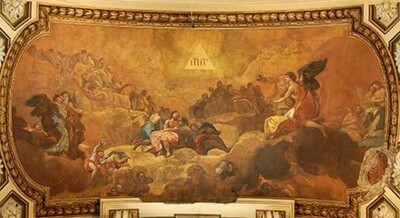- Cronología
- 1772
- Ubicación
- Museo Goya. Colección Ibercaja, Zaragoza, Spain
- Dimensiones
- 75 x 152 cm
- Técnica y soporte
- Oil on canvas
- Reconocimiento de la autoría de Goya
- Documented work
- Titular
- Ibercaja Collection
- Ficha: realización/revisión
- 04 Oct 2010 / 13 Jun 2023
- Otros títulos:
-
The Glory (La Gloria)
Goya (on the back in large letters).
As described in rec. no. 2.4.1, this sketch was submitted to the Building Committee of the Metropolitan Chapter of Zaragoza on 27 January 1772.
It initially belonged to Juan Martín Goicoechea, a friend of Goya. It was then inherited by the Counts of Sobradiel; there is a record of its belonging to María Pilar Alcibar, the second wife of the Count of Gabarda, in 1867. When the exhibition in homage to Goya was held in Zaragoza in 1928, it was in the possession of Sancho de Castro. It was acquired by José Gudiol Ricart from Barcelona in around 1965. In 2003 it was purchased by Ibercaja.
The frame bears a label that confirms that it formed part of the exhibition entitled ‘Exposición de Arte Retrospectivo' held in Zaragoza in 1908, at which time it belonged to the Count of Sobradiel.
To a large extent the sketch corresponds to the large format fresco, although it does feature some subtle variations. There are alterations also visible to the naked eye, which have been well documented using radiography techniques.
It is a composition in the baroque style which clearly displays the Italian influence that the artist had absorbed during his recent stay in that country.
The contrasting light and shade which gives a sense of space to the composition is more notable in the sketch than in the final painting.
The canvas features a black ground visible through the craquelure which affects the work. The vivid colour palette dominated by the golden tones used for the skies accentuates the delicate technique used by Goya for this sketch.
See Adoration of the Name of God.
Cleaned in 1993.
-
Exposición de obras de Goya y de objetos que recuerdan las manufacturas artísticas de su épocaMuseo de ZaragozaZaragoza1928organized by la Real Academia de Nobles y Bellas Artes de San Luis in collaboration with the Junta del Patronato del Museo Provincial. April 1928
-
GoyaKoninklijk Kabinet van Schilderijen MauritshuisThe Hauge1970organized by Ministerio de Estado y Asuntos Culturales and Réunion des Musées Nationaux, July 4th to September 13th 1970. Exhibited also at the Musée de l’Orangerie des Tuileries, Paris, October 25th to December 7th 1970, consultant editors Jeannine Baticle and A. B. de Vriescat. 1
-
Goya joven (1746-1776) y su entornoMuseo e Instituto Camón AznarZaragoza1986consultant editorl José Rogelio Buendía. November 21st to December 20th 1986cat. 24
-
GoyaLa Lonja, Torreón Fortea y Museo Pablo GargalloZaragoza1992consultant editor Julián Gállegocat. 4
-
Goya. El Capricho y la Invención. Cuadros de gabinete, bocetos y miniaturasMuseo Nacional del PradoMadrid1993from November 18th 1993 to February 15th 1994. Exhibited also at the Royal Academy of Arts, London, March 18th to June 12th 1994 and The Art Institute of Chicago, Chicago, July 16th to October 16th 1994, consultant editors Manuela B. Mena Marqués and Juliet Wilson-Bareaucat. 2
-
Goya: Prophet der ModerneAlte NationalgalerieBerlin2005from July 13th to October 3th 2005. Exhibitied also at the Kunsthistorischemuseum, Vienna, October 18th 2005 to January 8th 2006, consultant editor Manuela B. Mena Marquéscat. 1
-
Goya e ItaliaMuseo de ZaragozaZaragoza2008organized by the Fundación Goya en Aragóna, consultant editor Joan Sureda Pons. From June 1st to September 15th 2008cat. 196
-
Goya y Zaragoza (1746-1775). Sus raíces aragonesasMuseo Goya. Colección IbercajaZaragoza2015cat. 8
-
Vie et ouvre de Francisco de GoyaParísOffice du livre1970pp. 38, 82, cat. 31
-
BarcelonaPolígrafa1970vol. I, p. 238, vol. II, pp. 32-36 (il.)
-
Goya. El capricho y la invención. Cuadros de gabinete, bocetos y miniaturasMadridMuseo del Prado1993pp. 106-109 (il.), 344 (nº 2)
-
Los bocetos y las pinturas murales del Pilarcol. col. Mariano de Pano y RuataZaragozaCaja de Ahorros de la Inmaculada de Aragón1987pp. 47 (il.), 93-94 (il.)
-
Goya y Aragón. Familia, amistades y encargos artísticoscol. Col. Mariano de Pano y RuataZaragozaCaja de Ahorros de la Inmaculada de Aragón1995pp. 91-92 (il.)
-
Goya y Zaragoza (1746-1775). Sus raíces aragonesasZaragozaFundación Goya en Aragón, Ibercaja y Gobierno de Aragón2015pp. 120-123

